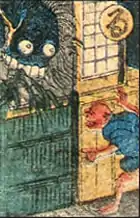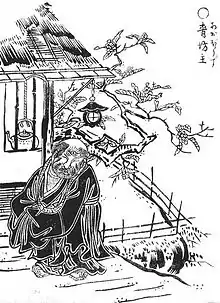Aobōzu
Aobōzu (青坊主, "Blue priest") is a Japanese yōkai (spirit) found in a number of Japanese legends. Stories about aobōzu, in particular the exact details of the spirit, vary widely.

As well as appearing in Japanese folklore, the aobōzu has also been depicted numerous times in traditional Japanese art; examples include one depiction of aobōzu found in Toriyama Sekien's {{|e-hon}} tetralogy Gazu Hyakki Yagyō.
In folk legends
Though the exact details of the aobōzu vary throughout legends, with differences often split along regional lines, the aobōzu is typically depicted as a large humanoid figure resembling a bōzu (priest). The exact nature of the aobōzu's actions, or the nature of its haunting, also vary; though the aobōzu is simply said to appear in Minabe, Hidaka District, Wakayama Prefecture,[2] in contrast, appearances of the aobōzu in Kaneyama, Ōnuma District, Fukushima Prefecture are said to be a weasel disguised as an aobōzu.[3] In Gifu Prefecture and Hiroshima Prefecture, appearances of the aobōzu are said to be a tanuki disguised as an aobōzu.[4][5] Appearances and stories of the aobōzu also appear in other areas, such as Haibara District, Shizuoka Prefecture.[6]
Nagano Prefecture
In Nagano Prefecture, a few variants of the aobōzu legend exist. In one, if a person stops breathing and spins around 7 times at the base of a certain pine tree, an aobōzu is said to appear and say "don't trample the rocks, don't snap the pine tree".
Shizuoka Prefecture
In Shizuoka Prefecture, it is said that in spring, children who come home late around the time of sunset and run across a wheat field may be kidnapped by an aobōzu appearing from the wheat. The legend is used in part as a reason for not letting children out into the fields at evening in springtime.[7]
Okayama Prefecture
In Okayama Prefecture, an aobōzu with a blue body or blue clothes is said to appear in vacant houses and other places.[8]
Yamaguchi Prefecture
In Yamaguchi Prefecture, aobōzu are said to be mountain gods (Yama-no-Kami) who have taken on the appearance of a small priest. In this legend, aobōzu are said to appear before people and suggest they take part in a sumo match with them; despite their small size, the aobōzu, having the powers of a mountain god, is said to toss people easily if they overconfidently take them on.[9]
Kagawa Prefecture
In Kagawa Prefecture, aobōzu are said to appear before women and ask, "how about hanging your neck?". In this legend, the aobōzu disappears if rejected, but if the woman ignores them without saying anything, the aobōzu forcefully attack the woman, rendering her unconscious before hanging her by the neck.[10][11]
Yamagata Prefecture
In Yamagata Prefecture, it is said that the bathroom in one elementary school along the base of a mountain is haunted by an aobōzu. In this legend, the face of a priest with a blue head appears from the toilet and stares at whoever is using it.[12]
Fukushima Prefecture
Similar to Yamagata Prefecture, in Fukushima Prefecture, in the first half of the 1930s, it is said that an aobōzu would appear in an elementary school bathroom, and it is said that the students at the time were so fearful of it, they would not use the toilet.[13]
In urban legends
Beginning in the Shōwa period, urban legends and school horror tales featuring the aobōzu became popular.
In the Gazu Hyakki Yagyō

In Sekien Toriyama's tetralogy Gazu Hyakki Yagyō, a potential depiction of an aobōzu shows it as a one-eyed priest standing next to a thatched hut. Despite the similarities to the aobōzu legend in appearance, the Gazu Hyakki Yagyō, as an e-hon picture book, did not come with accompanying explanatory text, meaning that the image may not show an aobōzu, and instead may be intended to depict another yōkai,[8] such as the mehitotsu-bō (one-eyed monk) commonly depicted in Edo period artworks, such as the Hyakkai Zukan by Sawaki Sūshi.[14] Toriyama, playing into the fact that the word for blue in Japanese ("ao") can refer to immaturity, may also have intended to depict an insufficiently trained priest as a yōkai.[15]
References
- Katsumi Tada (1998). Edo Yōkai Karuta (江戸妖怪かるた, Edo Period Ghost Cards) (in Japanese). Kokushokan Kōkai. p. 18. ISBN 978-4-336-04112-8.
- 大嶋一人他編, ed. (1995). "南部川の民俗". 近畿の民俗. 日本民俗調査報告書集成. Vol. 和歌山県編. 三一書房. p. 473. ISBN 978-4-380-95551-8.
- "福島県大沼郡金山町 調査報告書". 常民. 中央大学 民俗研究会 (26): 126. February 1990. NCID AN00116782. Archived from the original on 2016-03-04. Retrieved 2010-11-06.
{{cite journal}}: CS1 maint: bot: original URL status unknown (link) - 河出碩文 (1989). "人魂はある". 美濃民俗. 美濃民俗文化の会 (262): 492. NCID AN00235544. Archived from the original on 2016-03-04. Retrieved 2015-08-26.
{{cite journal}}: CS1 maint: bot: original URL status unknown (link) - 小笠原俊郎 (1933). "備後の俗信". 旅と伝説. 三元社. 6 (3号(通巻63号)): 75–76. NCID AN00139777. Archived from the original on 2016-03-04. Retrieved 2015-08-26.
{{cite journal}}: CS1 maint: bot: original URL status unknown (link) - "静岡県榛原郡相良町旧地頭方村". 民俗採訪. 國學院大學 民俗学研究会 (昭和59年度号): 161. October 1985. NCID AN00313874. Archived from the original on 2016-03-04. Retrieved 2010-11-06.
{{cite journal}}: CS1 maint: bot: original URL status unknown (link) - 今野圓輔編著 (1981). 日本怪談集 妖怪篇. 現代教養文庫. 社会思想社. p. 38. ISBN 978-4-390-11055-6.
- Kenji Murakami, editor (2000). Yōkai Jiten (妖怪事典). The Mainichi Newspapers Co. pp. 3–4. ISBN 978-4-620-31428-0.
{{cite book}}:|author=has generic name (help) - 松岡利夫 (1957). "山の神信仰 山口県の場合". 伊勢民俗. 伊勢民俗学会. 3 (3・4号): 5. NCID AN10234424. Archived from the original on 2016-03-04. Retrieved 2015-08-27.
{{cite journal}}: CS1 maint: bot: original URL status unknown (link) - 武田明 (1984). "仲多度郡琴南町美合の妖怪と怪談". 香川の民俗. 香川民俗学会 (41): 4. NCID AA11566406. Archived from the original on 2016-03-04. Retrieved 2015-08-27.
{{cite journal}}: CS1 maint: bot: original URL status unknown (link) - 武田明 (1985). "海と山の妖怪話". 香川の民俗 (44): 7. Archived from the original on 2016-03-04. Retrieved 2015-08-26.
{{cite journal}}: CS1 maint: bot: original URL status unknown (link) - 山口敏太郎 (2007). 本当にいる日本の「現代妖怪」図鑑. 笠倉出版社. p. 156. ISBN 978-4-7730-0365-9.
- 松谷みよ子 (1987). 現代民話考. Vol. 第二期 II. 立風書房. pp. 99–100.
- Natsuhiko Kyogoku, Katsumi Tada (editors) (2000). Yōkai Zukan (妖怪図巻). Kokushokankokai Inc. pp. 164–165. ISBN 978-4-336-04187-6.
{{cite book}}:|author=has generic name (help) - Katsumi Tada (2006). Hyakki Kaidoku (百鬼解読). Kodansha Publications. Kodansha. pp. 87–88. ISBN 978-4-06-275484-2.